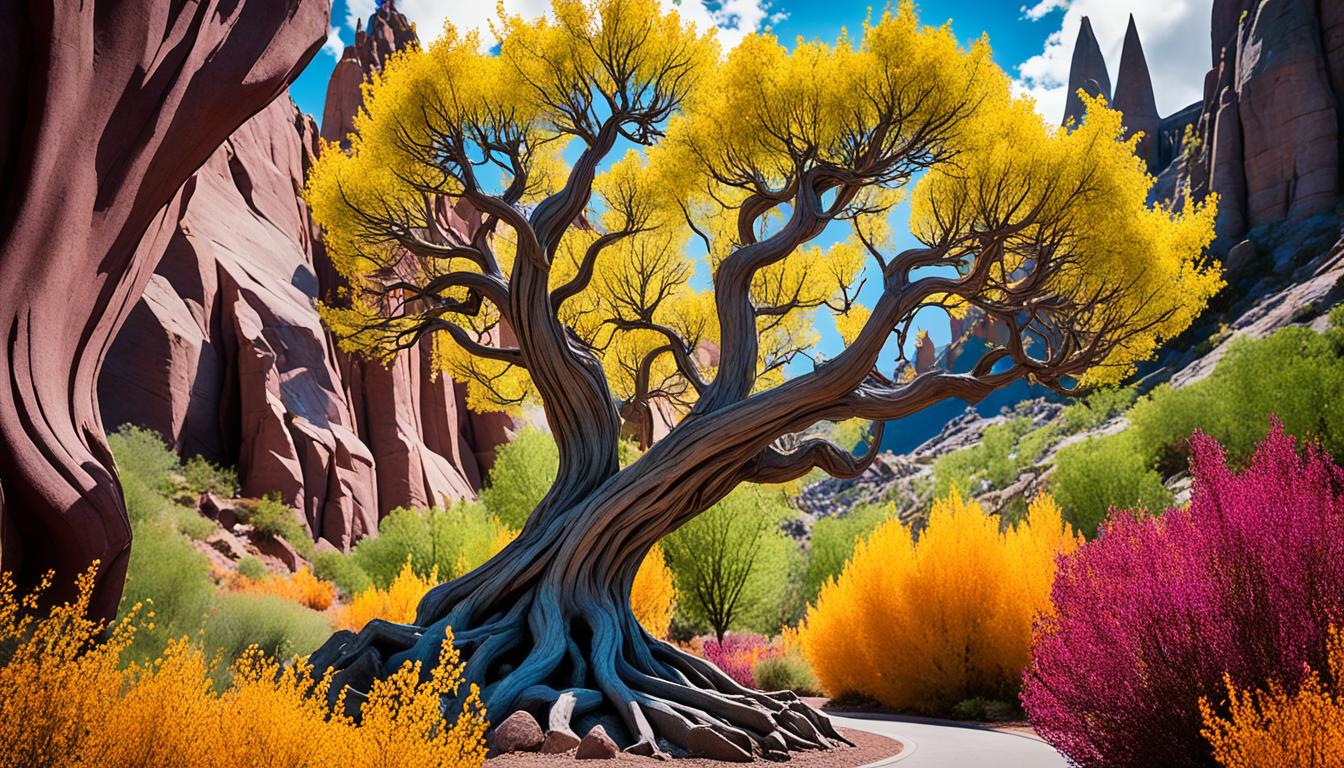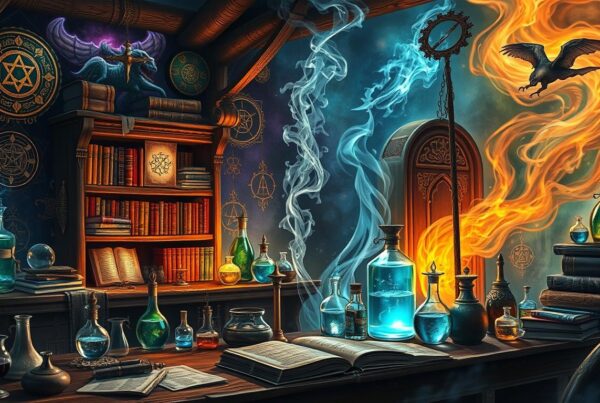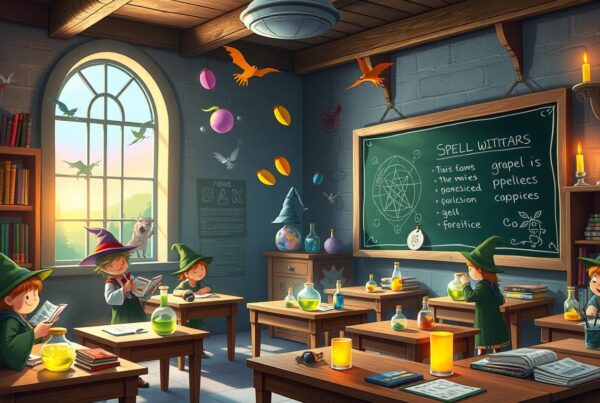Ever wonder about the magical plants in Harry Potter? Let’s explore them together. You’ll learn about plants like the Virginia Sneezeweed. It grows up to 3.5 feet and is used in sneezing powder1.
There’s also the Sensitive Joint-vetch found in coastal marshes. It’s known for its healing powers1. Each magical herb and fungus has a unique story.
Join us on a journey to learn about these magical herbs. They’re in Hogwarts and the Forbidden Forest. Discover how these plants mix real botany with the magic of J.K. Rowling’s universe.
Introduction to the World of Harry Potter Herbology
In the world of Harry Potter, Introduction to Herbology is key. It’s about learning magical horticulture through J.K. Rowling’s stories. Students get to know plants with magical powers2. Old books like Hortus Sanitatis and Kreutterbüch von allem Erdtgewächs also talk about plants. They show how plants can heal or harm, like the mandrake in Harry Potter2.
Learning about these plants helps young wizards and witches. It teaches them about the enchanted flora and spell-casting3. This has been part of wizarding education since the sixteenth century. It was shown in Hieronymus Brunschwig’s Destillierbuch der rechten Kunst2.
The story of Harry Potter is full of wizards good at magic. But it’s the magical plants that really help them3. Eucharius Rösslin’s book from the sixteenth century talks about the bond between humans and plants2.
Studying Herbology is like going on an adventure. It teaches about magical horticulture and the secrets of wizardry and plants. Fans find connections between Rowling’s plants and real historical texts2.
Phyllida Spore’s Influence on Magical Botany
Magical botany is vast and unique, thanks to Phyllida Spore. She wrote “One Thousand Magical Herbs and Fungi.”4 This book is key for Hogwarts students and is by a famous Herbologist and Hogwarts Headmistress. Her work is a big part of Hogwarts’ history and lessons.
The Origin and Use of “One Thousand Magical Herbs and Fungi”
“One Thousand Magical Herbs and Fungi” details many magical plants. It’s sold for two Galleons at Flourish and Blotts, crucial for first-year students4. It explains the uses of magical plants, like healing with Dittany or making Wolfsbane Potion with Aconite5. The book mixes useful info with fascinating facts.
Phyllida Spore was also a respected Hogwarts Headmistress. Her book connects readers with magical history and famous magicians like Merlin6. It’s a guide for future Herbologists and links them to wizarding culture and Hogwarts history63.
Phyllida Spore’s work is vital for learning about magical plants at Hogwarts. She covers many plants, from Devil’s Snare to Mandrakes5. Her book helps students learn about magical botany.
Thanks to Phyllida Spore, the study of magical plants is alive and well. Her teachings are important for future wizards. Her dedication helps keep magic and Herbology growing through the ages.
The Role of Magical Plants in Hogwarts Curriculum
Hogwarts Herbology class teaches about magical plants. It combines botany with magic. Students learn by doing, working with magical plants.
Neville Longbottom is portrayed as Herbology’s star student in the Harry Potter series7.
Imagine a lesson with students handling mandrakes. Their cries can heal but are also dangerous. This shows how magical plants mix reality and fantasy.
Plants like gillyweed let Harry Potter breathe underwater. Neville showed a plant that shoots Stinksap. Hermione used bluebell flames to fight a harmful plant. These examples highlight how magical plants can do amazing things.
Lessons teach about growing magical plants. For example, Dittany Seeds grow fast and are used in healing. Students learn about time management and the importance of plant care.
In advanced classes, students learn about more complex plants. Bubotubers need careful handling to avoid boils. Wolfsbane, used in potions, shows how fantasy and real plant science are combined.
The greenhouse is where students work with bigger plants. They grow plants like the Chinese Chomping Cabbage and Shrivelfig. Cultivating Fluxweed and Venomous Tentacula requires large pots and careful attention.
Students also use Chopping Stations and Composters. These tools help them learn to experiment and innovate. Using Fertilizer can double the harvest, teaching lessons in care and reward.
Thus, the magical plants education at Hogwarts is not merely academic but a pivotal element in shaping a wizard’s everyday life, preparing them for the myriad of situations that their future may hold.
Magical Plants and Their Real-World Inspirations
Let’s dive into how real-world botanical inspirations shaped Harry Potter. The book Culpeper’s Complete Herbal has been loved for centuries8. It talks about plants and stars and how to use plants for healing. J.K. Rowling herself uses it for inspiration8.
Unlocking the Secrets Behind Harry Potter’s Botanical World
Teachers use Harry Potter plant secrets to make learning fun9. Rowling mixes old plant myths, like the Mandrake, with her magical stories. This shows how people have always been fascinated by plants8.
Mandrake and the Ancient Myths of the Mediterranean
The Mandrake plant has a big place in Mandrake mythology. It’s famous in the Mediterranean for being magical8. Its roots look human, and in Harry Potter, they scream. This idea comes from old stories.
Dittany is another magical plant in the Potter world. It’s linked to a real herb from Crete, known for healing9. This shows how Rowling uses real plant facts in her stories.
Below, see how magical plants in Harry Potter match up with real plants:
| Magical Plant | Real-World Counterpart | Mythological Association | Usage in Harry Potter |
|---|---|---|---|
| Mandrake | Mandragora officinarum | Used as love potions and amulets in Mediterranean lore | Restorative properties for petrified individuals |
| Dittany | Origanum dictamnus | Held sacred on Crete, ancient healing herb | Healing severe wounds and promoting recovery |
| Moly | Allium moly | Protection against witchcraft in Greek mythology | Defense against hexes and jinxes |
| Wolfsbane | Aconitum (also known as monkshood or aconite) | Connected to werewolves and shape-shifting in folklore | Ingredients in potion to manage werewolf transformations |
The stories of these amazing plants keep inspiring us. They make the Harry Potter world feel real and magical.
Dittany: The Healing Herb of the Wizarding World
Dittany herb is magical and heals fast. It comes from Crete and is key in healing spells. This herb is also in Wiggenweld Potion for love and tummy aches910.
Dittany is like a natural bandage for wizards. It helps with serious injuries. When used on the skin, it heals minor cuts quickly. It shows how magic and health care work together.
“One must always have faith in the healing magic of plants.” This saying fits Dittany perfectly. It shows nature’s power, as seen in Harry Potter and real life9.
Dittany isn’t just make-believe. It connects us to real plant science. This helps us learn and get creative, like what Alan McCormack suggests.
In the end, Dittany is amazing for wizard and real-life healing. It’s as important as spells to witches and wizards. It inspires us to learn and imagine.
Flobberworm Mucus and Potion-Making Essentials
Flobberworm Mucus is super important in potion-making. It makes potions thick. About 80% of potions need this thickening stuff to work right11.
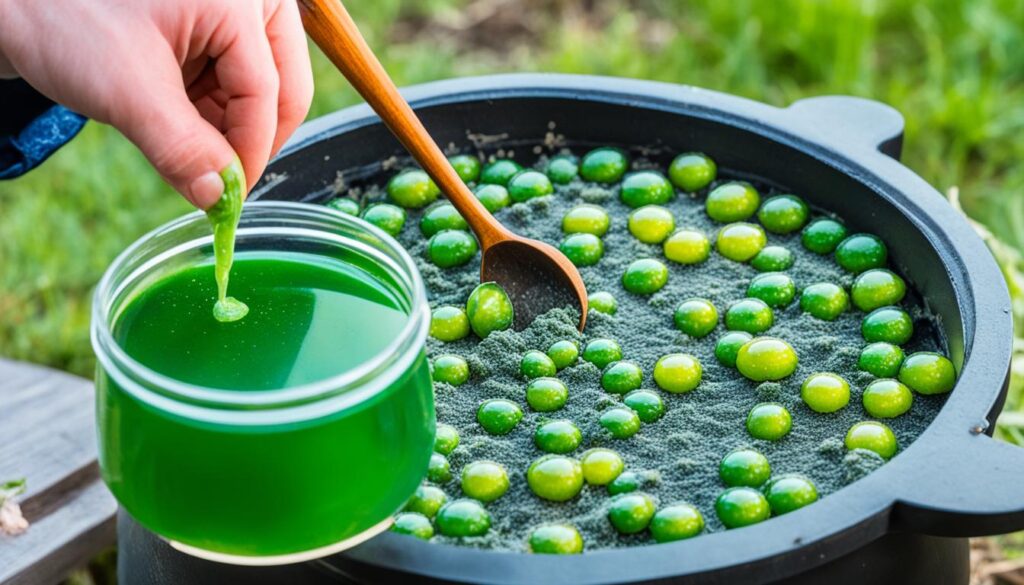
Making potions is tricky but fun. Some potions are easy to make, like Doxycide. Others, like the Forgetfulness Potion, are for beginners. Hogwarts teaches these potions to help students learn more as they grow11.
It’s cool how simple ingredients can make powerful potions. Skele-Gro, which heals bones fast, doesn’t need many ingredients. This shows that not all powerful magic needs rare stuff11.
Some potion ingredients come from magical creatures. For example, Flobberworm Mucus is one. A study found 34 different ingredients used in 11 potions. This shows how much there is to learn12.
| Potion Name | Simplicity Index | Main Ingredients | Magical Properties | Preparation Complexity |
|---|---|---|---|---|
| Doxycide | Low | Flobberworm Mucus, Bundimun Secretion | Pest-Repelling | Minimal stirring and simmering |
| Forgetfulness Potion | Very Low | Lethe River Water, Valerian Sprigs | Memory-Affecting | Simple preparation, first-year level11 |
| Skele-Gro | Medium | Bone Regrowth Stimulants, Flobberworm Mucus | Healing | Moderate boiling duration |
| Hair Raising Potion | Very Low | Elixir of Euphoria, Rat Tails | Cosmetic Alteration | Few ingredients, simple steps11 |
Learning to make potions is a careful process. You must be safe and exact. Some ingredients, like belladonna, are risky. Exact stirring and cooking times are key for the potion to work right12.
Shelf life is also important for potions. Some last a month, others just a day. Knowing how to store them is big. It keeps the potions working well12. The craft of potion-making is about being exact and knowing the magic12.
Potion-making in Herbology, whether it be for healing, altering appearances, or providing protection, relies on a diverse array of ingredients including the ubiquitous Flobberworm Mucus. This flexible medium is more than a mere thickener; it’s a testament to the interconnectedness of all magical beings and the creativity inherent in the magical arts.
Moly and Aconite: Potent Plants With Protective Powers
The Harry Potter books are full of cool magic plants. Protective plants in wizardry are super important. Moly and Aconite are two special plants with strong protection powers.
In “One Thousand Magical Herbs and Fungi”, we learn about Moly enchantments. They keep away dark magic4. Moly has a black stem and white flowers. It shows how it can protect wizards who know their stuff. With knowledge from the book, Moly can fight against bad spells4.
Aconite, also known as Monkshood or Wolfsbane, helps protect against werewolves4. Hogwarts students learn to use it in potions class. The Aconite Fluid potion needs 10 minutes to brew13. It only lasts a year, which shows it’s really strong.
Harry Potter and his friends learn a lot about these magical plants. They fix their school books to remember this knowledge4. This helps them stay connected to their magical roots.
So, Moly and Aconite are not just useful. They help make the wizarding world of Harry Potter special. The protective plants in wizardry give wizards ways to stay safe. They show how magic plants can be really powerful.
Harry Potter Magical Plants
Enter the green world of Harry Potter. Here, magical plants and Herbology magics meet. This creates a wide range of Potterverse plants. These plants add magic to the stories and school lessons, making them more fun. The magic herbs show how many different plants there are in this world. This makes us love the series even more.
Saving real magical plants in the real world is now very important. The Furbish Lousewort is rare and grows between Maine and New Brunswick, Canada1. The Virginia Sneezeweed, which can grow more than 3 feet, is also in danger because of water changes1. These real plants remind us to save our planet’s precious plants.
| Magical Plant | Real-World Status | Location | Conservation |
|---|---|---|---|
| Swamp Pink | Preserved Wetland Jewel | Wetlands | Supported by Service Biologists |
| America Hart’s-tongue Fern | Threatened Species | Humid Forest Sinkholes | Protected Under Endangered Species Act |
| Sensitive Joint-vetch | Endangered due to Habitat loss | Coastal Marshes | Conservation Efforts by Service Biologists |
1Swamp Pink blooms beautifully and many people work to protect it. The American Hart’s-tongue Fern grows in special places and is protected1. The Sensitive Joint-vetch needs help to grow well
There’s a special connection between Herbology magics and saving real plants. It teaches us to care for our own enchanted botanicals. It shows that plants, in stories or real life, need love and care to keep their magic alive.
The Mandrake’s Lethal Cry and Its Connection to Herbology
The Mandrake’s cry is steeped in old myths. It’s part of the deadly magical plants lore. Students at Hogwarts learn to respect and be careful around Herbology dangers. The Mandrake is a key example. Its deadly cry reflects the real risk Mediterranean Mandrakes pose. They have big leaves and can cause hallucinations14.
Bible stories and old superstitions talk about the Mandrake’s power. They say hearing its scream could harm you. These stories show the danger of the Mandrake’s cry. They tell how people used the Mandrake in different ways14.
Getting a Mandrake root was risky. People tied a dog to the plant to safely get it. This shows the very real Herbology dangers linked to these deadly magical plants14.
In Harry Potter, the danger of these plants is shown well. Students wear earmuffs to avoid the Mandrake’s cry. This shows how the books include old beliefs about deadly plants15.
| Historical Use | Medicinal Application | Folklore |
|---|---|---|
| Anesthesia for surgery14 | Treating rheumatic pains14 | Amulets for good fortune14 |
| Incense in ancient Greece14 | Treatment for melancholy and convulsions14 | Causing unconsciousness when consumed14 |
| Ingredient in witches’ flying ointment14 | Aphrodisiac and magical ritual component14 | Belief in a lethal cry during extraction14 |
Tomatoes and potatoes don’t scream like Mandrakes. When they came to Europe, people were wary. They are related to the dangerous Nightshade family. Now, tomatoes and potatoes are grown widely. They’re different from their feared relative16.
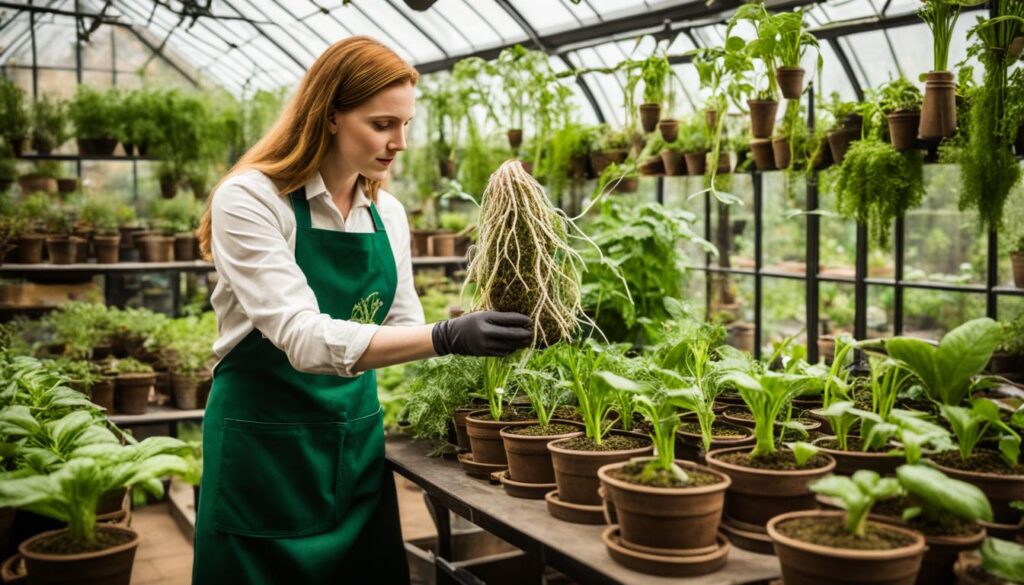
Mandrakes are especially important in Herbology. They show how plants and humans are linked. This relationship is about both good and bad, amazing and scary things.
Magical Properties of the Wiggentree and Alihotsy
Diving into the wizarding world’s plants, we find the Wiggentree powers and Alihotsy effects amazing. Each plant gives the magical world its own special gift. They show us how nature’s gifts can help those who know how to use them.
Understanding the Defensive Powers of the Wiggentree
The Wiggentree is a powerful tree. It offers magical protection. Little creatures called Bowtruckles guard it carefully17.
Its branches protect against dark forces. This fact is known and proven18. It shows how magical and everyday beings’ lives are connected.
Alihotsy: The Laughter-Inducing Leaves
The Alihotsy tree makes people laugh. Its leaves cause bursts of laughter19. They’re used in potions that can make you feel great but can also be too much19.
Still, Alihotsy leaves can be dangerous if not used right. They need careful handling18. A special treacle can fix the too much laughter, making things balanced again19.
Dangerous Beauties: Devil’s Snare and Venomous Tentacula
The Wizarding World is both charming and risky. This is especially true for its plants. Devil’s Snare is known for its deadly touch despite looking harmless20. Venomous Tentacula, with its dangerous grab, is another threat in Hogwarts20.
These plants show the beauty and danger of the magical botanical world. Let’s look at Devil’s Snare and Venomous Tentacula. We will explore their dangers and how to handle them safely:
| Magical Plant | Hazard | Preferred Habitat | Repellent/Defensive Strategy |
|---|---|---|---|
| Devil’s Snare | Vining tendrils that ensnare | Dark, damp environments | Exposure to light or fire |
| Velvet Venomous Tentacula | Grasping vines with a poisonous bite | Greenhouse 3 at Hogwarts | Meticulous pruning and use of protective gloves |
To understand these plants is important. Devil’s Snare reacts by tightening its grip20. Venomous Tentacula, though not as deadly, still requires caution20.
The Devil’s Snare and Venomous Tentacula add excitement and danger. They remind us of the fine line between beauty and peril in magical plants20.
Gillyweed: Aquatic Adventures and Gills
In the wizarding world, Gillyweed properties are very exciting. This plant comes from Hogwarts’ grounds. It gives people magical gills and webbed hands and feet for swimming21. In “Harry Potter and the Goblet of Fire,” Gillyweed helped Harry Potter. He could swim in the Great Lake at Hogwarts21.
The effects of Gillyweed last about an hour. This makes it super useful10. It works in both fresh and saltwater. It shows how Gillyweed can adapt very well10.
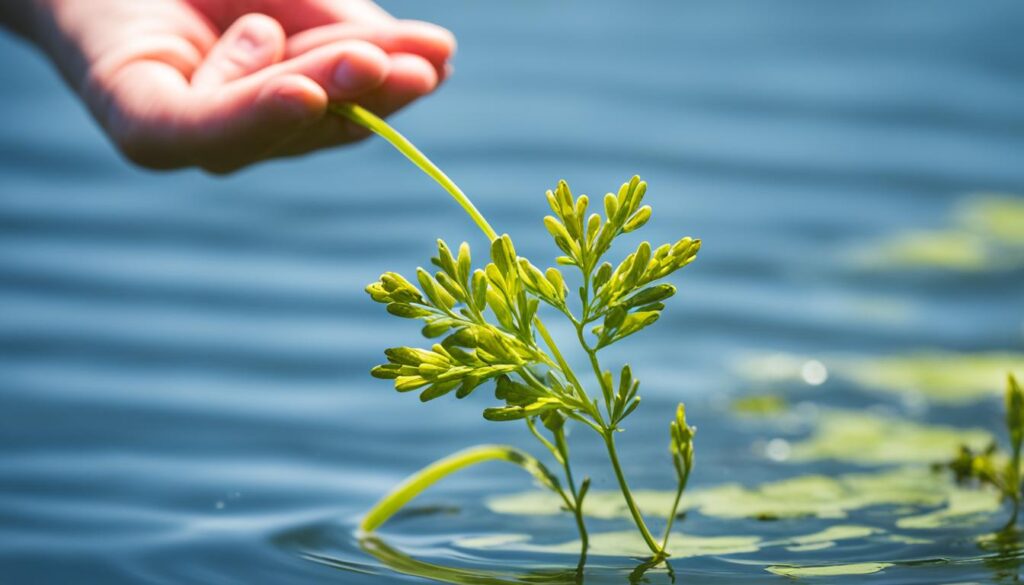
Gillyweed is used in competitions too. Like in the Triwizard Tournament. It gives an advantage in water. Schools teach about it along with other magical plants. This helps students learn how each plant is special.
Doctors in the wizarding world are also interested in Gillyweed. Growing gills is pretty cool. It might help with living and healing underwater someday. This makes Gillyweed very important for research.
So, Gillyweed is key for exploring underwater worlds. It shows how magical plants help wizards adapt to the sea. It’s really important for both fun and learning in the magical world.
Behind the Scenes: Inconsistencies and Trivia
The magical book, “One Thousand Magical Herbs and Fungi,” changed a lot through the Harry Potter series. Its name changed in different books and movies, showing fun little mistakes. Fans love finding these details in J.K. Rowling’s big story.
The Evolution of “One Thousand Magical Herbs and Fungi” Through the Series
The book’s name sometimes changed in the series. This showed how the magic world is always changing. It was an interesting part of the wizarding world.
Adaptations and Artistic Interpretations in Films and Games
Movies brought the magic plants of Hogwarts to life in a new way. Games let fans explore these plants more. Both added fun and learning for fans.
Some woods make great wands because they are special22. Each wand, like cherry or black walnut, picks its owner. This adds deep stories to the wizarding world.
Harry Potter games take players into a magical forest. They learn about the magic in every tree and twig. This honors the stories from the books.
Wolfsbane and Wormwood: A Deeper Look Into Snape’s Potion Class
In J.K. Rowling’s world, plants like Wolfsbane and Wormwood are more than potion parts. They have deep histories and meanings beyond magic. Wolfsbane, or Monkshood, is linked to werewolf legends and has toxic traits. It also represents dislike of people23. Wormwood is used for stomach issues and in making Vermouth. It stands for deep sadness in old flower language24.
Real-Life Applications of Wolfsbane and Wormwood
Wolfsbane is tied to tales of protection from werewolves and spirits. Yet, it’s very poisonous in the real world. Wormwood is key in cooking and traditional medicine. It helps treat many illnesses23. These plants show how real and magical worlds blend. Their stories, symbolism, and uses are rich and complex.
The Hidden Messages in Snape’s First Words to Harry
Snape’s first words to Harry hide a lot of meaning. They suggest Snape’s deep regret and the story that will come out. He talks about Asphodel and Wormwood. These plants symbolize regret and sorrow. Snape’s choice of them hints at his sadness over Lily’s death2324.
They reflect Snape’s tough outside and his hidden grief. Snape is a man torn by love and loss. This connects to his name, which means to cut apart23.
Snape’s story is shown in the flower symbols in the books. Lilies stand for beauty, and Petunia shows anger. This is like the bad blood between the sisters and Snape’s own struggles23. Looking at flower meanings lets us see deeper into Snape’s heart. It shows more story layers through Herbology and its symbols24.
| Plant | Symbol in Victorian Language | Real-World Use | Role in Harry Potter |
|---|---|---|---|
| Asphodel | My regrets follow you to the grave24 | Funeral flower | Ingredient in Draught of Living Death23 |
| Wormwood | Absence; bitter sorrow24 | Gastrointestinal treatment, Vermouth ingredient | Symbolizes Snape’s regret2324 |
| Wolfsbane | Misanthropy23 | Toxic (handled with care) | Associated with protection against werewolves |
Conclusion
In the Harry Potter books, Herbology is a fun dive into magical plants. It’s where you hear a tomato plant cry and a Mandrake scream. These sounds remind us of how magic and real life mix. Hogwarts students learn about these magic plants. They see how these plants help in the wizarding world. Like how Wolfsbane helps werewolves stay calm, or Wormwood is used in powerful potions251826. This shows us how the magical and real-world plants are similar. The use of Wormwood in potions is like old-time medicine with Artemisia plants26.
Learning about Harry Potter’s magical plants is fun. It helps us see how fantasy is linked to our culture and myths. Some plants like Aconitum are dangerous but also have powers like Dittany, which can heal. These plants tell us stories about nature being both beautiful and scary25. We learn not just about magical plants but also about being careful and curious. These stories teach us to respect all living things.
Exploring Herbology in Harry Potter makes us appreciate the connection between the real and imagined worlds. It celebrates the variety of life and makes us curious about our own planet’s plants251826. Rowling’s stories inspire us to think, explore, and respect the magical and real nature around us.
Source Links
- https://usfws.medium.com/the-real-magical-plants-in-harry-potter-e937ea3b560e
- https://www.nlm.nih.gov/exhibition/sciencemagicmedicine/exhibition3.html
- https://en.wikipedia.org/wiki/Magic_in_Harry_Potter
- https://harrypotter.fandom.com/wiki/One_Thousand_Magical_Herbs_and_Fungi
- https://www.cbr.com/helpful-harry-potter-plants-in-herbology/
- https://www.degruyter.com/document/doi/10.7208/9780226431413-021/html
- https://www.gardendesign.com/plants/harry-potter-herbology.html
- http://www.the-leaky-cauldron.org/2018/10/04/harry-potter-a-history-of-magic-and-plant-lore-part-one-j-k-rowling-and-culpepers-complete-herbal/
- https://www.edutopia.org/article/magical-approach-science-lessons/
- https://www.ugaoo.com/blogs/green-lifestyle/magical-trees-plants-from-harry-potter
- https://screenrant.com/harry-potter-potions-easiest/
- https://www.snitchseeker.com/term-32-september-december-2012/potions-recipe-book-91876/
- https://wandw.wikidot.com/potions
- https://en.wikipedia.org/wiki/Mandrake
- https://www.nlm.nih.gov/exhibition/sciencemagicmedicine/education/highereducationdetail0000.html
- https://www.bbc.com/news/magazine-33506081
- https://hogwartsmysterywt.weebly.com/herbology.html
- https://screenrant.com/harry-potter-wizarding-world-most-useful-plants-mandrake-gillyweed-whomping-willow/
- https://breezewiki.com/harrypotter/wiki/Alihotsy
- https://www.eastbaytimes.com/2007/07/21/garden-magic/
- https://www.mugglenet.com/2019/03/magical-plants-we-wish-were-real/
- https://www.wizardingworld.com/writing-by-jk-rowling/wand-woods
- https://www.wizardingworld.com/features/lily-potter-petunia-and-the-language-of-flowers
- https://www.goodhousekeeping.com/uk/news/a563336/severus-snape-harry-potter-philosophers-stone-first-words-meaning/
- https://www.dailymail.co.uk/sciencetech/article-11923921/The-REAL-magical-plants-Harry-Potter-MailOnlines-guide-herbology-Muggle-world.html
- https://www.drcrean.com/magical-creatures-herbology-plant-s
